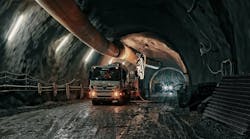Sustainable Mining Strikes IIoT Gold
Disruptions during the past year have forced us to critically re-examine every aspect of the supply chain. What better place to start than with mining, the origin of so many components of our products and processes? Concerns about global warming add to the importance of scrutinizing mining, since mining accounts for 2 to 3% of global energy consumption, and a World Bank report predicts that batteries and other components of green energy systems to reduce global warming may increase demand for graphite, lithium and cobalt 500% by 2050.
For millennia, mining was largely an inefficient, brute-force industry, extracting large amounts of materials through a combination of pickaxes and explosives. Only later in the process, often after the materials were transported to the point of use, were the truly valuable ores or petroleum separated from the waste. Its disposal from its place of origin frequently led to pollution of water supplies and creation of scarred landscapes (as the child of two geologists, one of my favorite Sunday night family activities in the early ‘50s was to watch molten slag, the by-product of steel production, light the night sky as it poured out of the Bethlehem Steel plant). Even worse, as easily extracted ore veins near the surface have been exhausted, it is necessary to drill deeper and in more remote areas, increasing both costs and environmental impacts.
Thus it may come as a surprise that mining companies are at the forefront of applying IIoT and other digital innovations to the mining process, reducing their climate impacts while simultaneously improving profits and operating efficiency.
The breakthrough that drew me into the subject comes from Tomra, the Norwegian manufacturer of the ubiquitous beverage-container recycling machines at your local supermarket. They’ve applied to mining the same sensor-based detection system that makes it possible to identify different drink companies’ containers and separate the types. It’s perhaps the ultimate in current IoT-based mining improvements, because the sensors separate valuable ores from waste byproducts right at the mine, avoiding needless traditional costs of transporting worthless materials to the point of use before they are separated and the wastes disposed of in areas ill-suited to that activity.
The approach works with a wide range of materials, from diamonds to limestone.
The sensors include X-ray transmission, laser, near-infrared and several others. They discriminate among various materials on the basis of factors such as atomic density and conductivity. Then an advanced nozzle blasts pressurized air at the rock to separate the valuable material from wastes.
At the Wa’ad Al Shamal plant in Saudi Arabia, Tomra sorting equipment separates the desired phosphate from chert, a byproduct. Normal milling processes cause extensive mechanical wear and low energy efficiency, but the Tomra sensors reduce the need for water separation by 45%, while also recovering millions-of-dollars’-worth of larger grain sizes of phosphate that are usually discarded in massive waste piles.
Overall, Tomra sorting machines reduced CO2 emissions by 155.607,375 metric tons around the world in 2020.
Baker Hughes zeroes in on maintenance as the key to reducing mining’s environmental impacts — and operating costs:
“Areas such as decreasing the steep cost of fleet maintenance and reducing the frequency of unplanned downtime are ripe for mining innovation today in order to meet demand tomorrow. Novel predictive maintenance approaches answer this need.”
They report huge potential savings through IoT-based predictive maintenance:
- “70% operating efficiency is the average, mostly due to breakdowns and stalled operations.
- 30-50% of operating costs are spent on maintaining plant, fleet and equipment.
- 3-5X more is spent on breakdowns and unplanned maintenance vs. planned maintenance.”
The Baker Hughes white paper cites a PwC study of how predictive maintenance at one mine drastically cut maintenance spending by 14%, leading to $8 million in operations savings. A real-time condition monitoring system installed on critical equipment avoided unplanned shutdowns and serious failures, while increasing equipment availability. All these components also reduced environmental impacts.
One Baker Hughes installation concentrated on mining pump stations, where the pumps are responsible for 97% of unplanned maintenance costs. Adding sensors monitoring the pumps plus real-time analysis, the operators save $3 million a year on pump maintenance.
Of all the mining operations and technology companies I researched, the one that stood out in terms of its comprehensive commitment to reducing environmental impacts (while improving profitability in the process) was the U.K-Australia RioTinto, the world’s third-largest mining company (by revenue). The firm went to the lengths of creating an integrated sustainability strategy in 2018:
“This strategy commits us to adopt high standards, often going beyond legal requirements, on … sustainability issues. Our goal is to achieve consistent, high-quality social and environmental performance across all of our operations and to increase our stakeholders’ knowledge of how we work through meaningful disclosures and transparency … We support the 2030 development agenda and contribute to the UN Sustainable Development Goals.
They are the only mining company that no longer produces fossil fuels, and also link executive compensation to progress toward achieving their sustainability goals. Their overall goal is to cut absolute emissions by 15% by 2030 and emissions intensity by 30% relative to their 2018 equity baseline, “consistent with a 45% reduction in absolute emissions, relative to 2010 levels…”
This goal aligns with the Intergovernmental Panel on Climate Change (IPCC) pathways reducing global warming to 1.5°C. The company commits to spend $1 billion on climate-related projects from 2020-24. The company’s long-range goal is net-zero emissions by 2050.
Ore transport is a major focus for Rio Tinto. AutoHaul , their fully-autonomous heavy-haul train system has traveled more than 7 million kilometers. They’re extending the Autonomous Haulage System, which also has worker safety and operating cost benefits, to 130 autonomous trucks in their iron ore operations. A central controller operates the trucks, using pre-defined GPS.
One tool that’s really digitized their operations is RTVis, a 3D data visualization tool that combines geotechnical, drill and blast, production and planning data, and can visualize both surface and sub-surface features. It uses a 3D gaming engine to “see” inside the operations: “We can fly over a site and dive down to the detailed information we need. We can hover over an excavator, follow a haul truck, or examine an orebody.” The results are more accurate drilling and blasting (with less use of explosives) and — as with the Tomra system — better waste classification, so the trucks carry more ore, and less waste material. They also use another major IoT tool, digital twins.
RioTinto is also remediating the damage from past mining practices. Particularly noteworthy is its project with the Kennecott copper mine in Utah. It is revegetating waste rockpiles, some as high as 1,200 feet, left from 100 years of mining. The project includes a collaboration with Brigham Young University’s Department of Plant and Wildlife Sciences to research innovative ways of reclaiming the dumps, including re-introducing trees that would have been found there 120 years ago, through “new technology to coat seeds to improve coverage and survival, finding ways to reduce invasive weeds growing on the waste rock and remotely accessing hard-to-reach parts where revegetation is taking place naturally,” according to marketing materials for the project.
Let’s not forget “mining” at the end of the supply chain. There’s also a growing movement toward depolymerization of plastics, so that waste plastics can be totally recycled into virgin plastic for reuse. Nexus is one company in this field, working with partners including Royal Dutch Shell and Chevron Phillips. Its process produces no wastewater and very low air emissions. The partners blend its products into their existing streams. Nexus is building sites in the U.S. and Europe.
A lot of utterly conventional mining still takes place, harming the natural environment and contributing to global warming, but these examples show that it is feasible for mining companies to employ the IIoT and other digital technologies to simultaneously boost profits and efficiency while reducing—and even reversing—environmental damage.
W. David Stephenson, principal of Stephenson Strategies (Millis, Massachusetts), is an IoT consultant and thought leader. His The Future Is Smart (HarperCollins Leadership), was one of the first books on IoT strategy.




